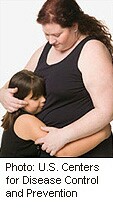
TUESDAY, Feb. 15 (HealthDay News) — Posting calorie counts of menu items at fast-food restaurants doesn’t appear to inspire teenagers and parents of younger children to order less-fattening meals, new research finds.
Researchers who studied menu choices at four fast-food restaurant chains before and after mandatory labeling took effect in New York City said the legislation did little to lower calorie consumption.
“We didn’t notice a change in calories purchased before and after labeling [went into effect],” said study leader Dr. Brian Elbel, assistant professor of medicine and health policy at the New York University School of Medicine and Wagner School of Public Service.
“Labeling [calories] is not going to be a silver bullet,” he said. Restaurant-related efforts to combat childhood obesity will need additional approaches, such as telling consumers an ideal range of calories for each meal, he added.
Fast food has been linked to rising rates of childhood and adolescent obesity, the authors note.
While teens at fast-food restaurants noticed the posted calorie counts at about the same rate as adults, this didn’t usually translate into ordering lower-calorie options, said the authors.
Their findings are published online Feb. 15 in the International Journal of Obesity.
As part of the nation’s new health-care reform act, restaurants with 20 or more locations must post the calorie content of their menu items. New York City was a pioneer in requiring labeling, launching its program in July 2008.
For two weeks that summer, Elbel and his team studied the fast-food choices of 349 children and teens, ages 1 to 17, in low-income areas of New York City and Newark, N.J., both before and after calorie labeling was introduced. Newark had no labeling requirement.
The restaurants were McDonald’s, Burger King, Wendy’s and Kentucky Fried Chicken. About 90 percent of the customers were ethnic or racial minorities.
The researchers asked customers as they entered to show them their receipt and to answer a set of questions in return for $2. The customers didn’t know before ordering what the researchers were studying.
Parents of younger children answered questions about their food choices for their kids.
Fifty-seven percent of teens in the New York sample said they noticed the label, but only 9% considered the information when ordering.
Teens bought 730 calories per order, on average, before the labeling appeared and 755 after. Parents ordering for their younger children ordered 610 calories before and 595 after — not enough of a reduction to be significant statistically.
About 35 percent of the teens said they ate fast food six or more times a week. Nearly three-quarters said taste influenced what they ordered.
For many customers, convenience of location led to restaurant choice.
Noting that the small size of their study is a limitation, the authors suggest that nationwide research be conducted once mandatory labeling is in effect from coast to coast.
The study findings echo previous research by Elbel’s team, which found just over a quarter of adults who noticed menu calorie information reported using it.
But a study by Dr. Pooja Tandon, of the University of Washington in Seattle, came up with conflicting results. That study, published last year, found that parents provided calorie counts at restaurants ordered about 100 fewer calories per meal for their 3- to 6-year-olds (enough to make a difference long-term), compared to parents not given such information.
After reviewing the results of the new research, Tandon said perhaps a longer follow-up is needed after menu changes to see a difference. “It is possible that repeated exposures are necessary before behavior change is seen, or a longer time is needed for restaurants to reformulate their offerings,” she said.
Another expert said this new research suggests that health information is needed before families visit fast-food restaurants. “Once a decision is made to go to a fast-food restaurant, nutrition information appears to not change choices,” said Connie Diekman, director of university nutrition at Washington University in St. Louis.
The study points to the need for better education about what constitutes healthy eating and what appropriate calorie intakes are per meal, she said.
More information
To learn how to read food labels, visit the U.S. Food and Drug Administration.

